This apartment in Chennai has implemented a sustainable wastewater treatment plant that does not rely on tankers to remove the sludge. Image: Shobana Radhakrishnan
Chennai has experienced rapid expansion in recent decades. But essentials such as water supply and sewage connections have not materialized in many parts of the city, despite the demands of residents. This has forced residents to look for alternatives, such as getting water from tankers and constructing their own sewage treatment plants (STPs).
Many apartments on the outskirts of Chennai, mainly on Old Mahabalipuram Road (OMR), have set up sewage treatment plants to treat the wastewater generated in the apartment complex. Since the building code requires a sewage treatment plant for multi-storey apartments, builders will usually build a sewage treatment plant and maintain it for a number of years. The handover to the respective residents’ welfare association (RWA) takes place later.
Often the challenge arises when RWAs need to manage the STP, as maintenance is a costly affair given the need for continuous power supply, hiring staff and budgeting for their salaries. In addition, many residents are also opposed to in-house STPs because of the foul odor that occurs during water treatment.
If the apartments rent sewage tankers to remove the sludge, it’s useless because the tankers end up mixing the waste in the waterways or storm sewers.
However, an apartment in Sholinganallur – The Central Park South in Chennai has set up an STP with a capacity of 135 kiloliters per day (KLD) so they don’t have to rely on the tanker trucks to clean up the sludge. The sludge is also recycled in-house, making the apartment complex self-sufficient in terms of waste water disposal. Notably, the STP also works to be foul odor free.
Here is a step-by-step guide on how this STP works.
Continue reading: Thoraipakkam has been within GCC limits since 2011 and is still awaiting a mains water and sewage system
How STP works in apartment in Chennai
Central Park South has 172 residential units in the complex. The STP facility supplies all units and the treated water is sent back to the apartments for reuse for flushing.
The waste water from the toilets in the apartments is collected in the main collection tank. On average, there is one such primary collection tank for every two blocks.
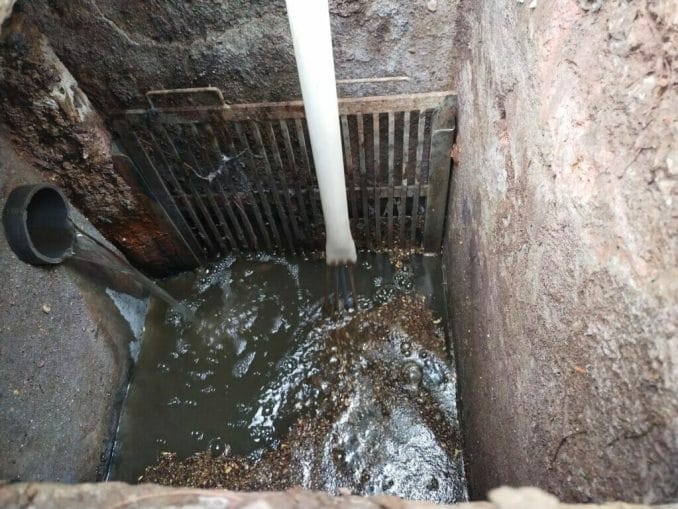 The raw water collected from the primary collection tanks is sent to the strainer tank. Here, the waste water is passed through the iron screen for filtering before it enters the aeration tank. The staff in charge of maintaining the treatment plants also use the white rod to check for the presence of solid waste and remove it from time to time. Image: Shobana Radhakrishnan
The raw water collected from the primary collection tanks is sent to the strainer tank. Here, the waste water is passed through the iron screen for filtering before it enters the aeration tank. The staff in charge of maintaining the treatment plants also use the white rod to check for the presence of solid waste and remove it from time to time. Image: Shobana Radhakrishnan
“It becomes a challenge when people are flushing all sorts of things like sanitary napkins and plastic sheeting down the toilet. It must be removed mechanically. So we redesigned that part of the tank and added the filters to sort out such waste,” says Rakesh Ohri, President of the Central Park South Owners Association.
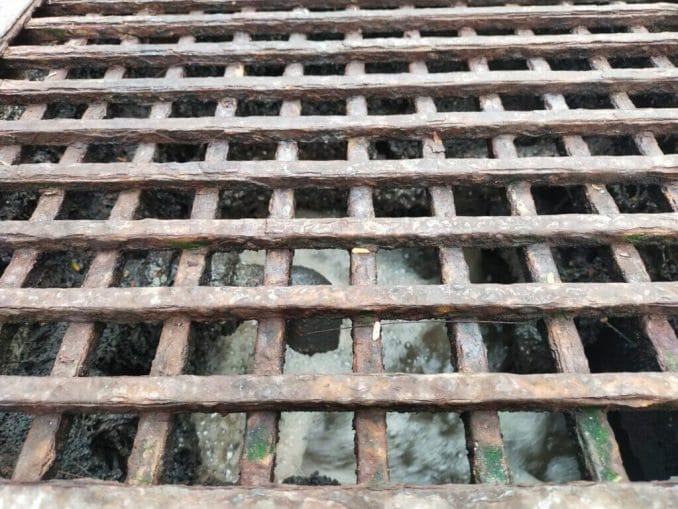 The filtered wastewater from the sieve tank flows to the activated sludge tank. The air is blown into the tank around the clock by the blower motors. “Many people try to save money by turning off these blower motors at night as they are high power motors (5hp) and use more electricity. Although these tanks are positioned to allow open air to enter, we have found that this is not enough for air circulation. That’s why we use the blowers here,” says Rakesh. Image: Shobana Radhakrishnan
The filtered wastewater from the sieve tank flows to the activated sludge tank. The air is blown into the tank around the clock by the blower motors. “Many people try to save money by turning off these blower motors at night as they are high power motors (5hp) and use more electricity. Although these tanks are positioned to allow open air to enter, we have found that this is not enough for air circulation. That’s why we use the blowers here,” says Rakesh. Image: Shobana Radhakrishnan
STP operators produce their own suspended solids mixtures (concentration of suspended solids used in an activated sludge tank during the activated sludge process) from cow manure, jaggery and urea. Although there are providers for this, the operators prefer to concentrate here themselves.
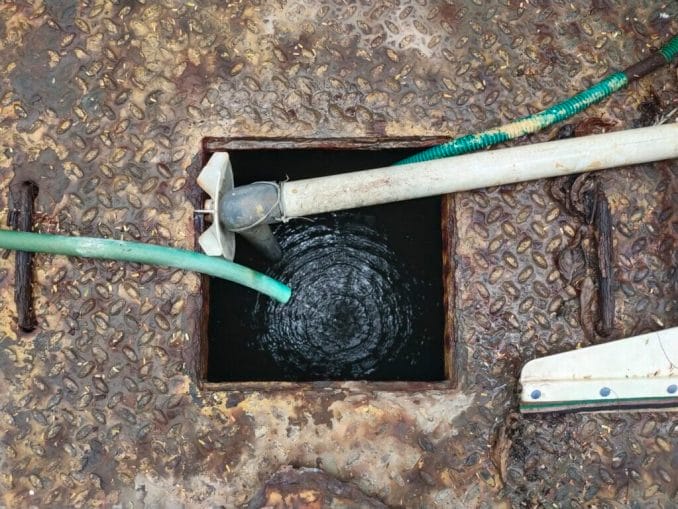 Water from the aeration tank flows to the settling tank where it stands still. As the sludge settles, the surface water reaches a certain point and overflows into the filtration tank. “If the moving water from the aeration tank is fed directly into the filter feed tanks, it clogs the tanks. That’s why it’s important to have a tailings pond,” says Rakesh. Image: Shobana Radhakrishnan
Water from the aeration tank flows to the settling tank where it stands still. As the sludge settles, the surface water reaches a certain point and overflows into the filtration tank. “If the moving water from the aeration tank is fed directly into the filter feed tanks, it clogs the tanks. That’s why it’s important to have a tailings pond,” says Rakesh. Image: Shobana Radhakrishnan
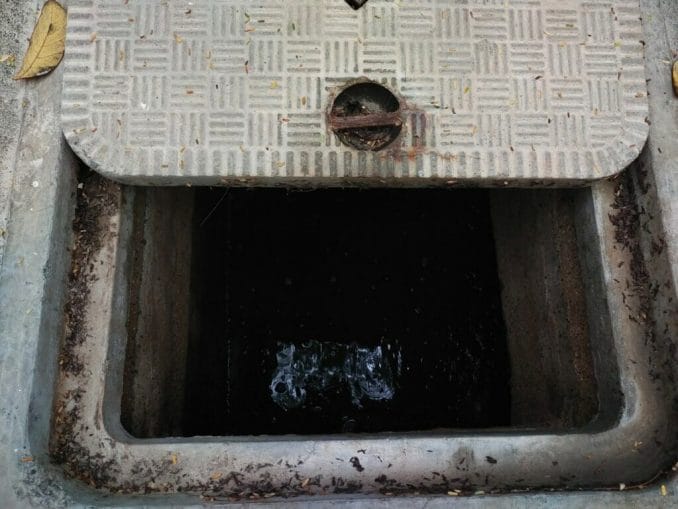 The surface water from the settling tank overflows into this filtration tank. Image: Shobana Radhakrishnan
The surface water from the settling tank overflows into this filtration tank. Image: Shobana Radhakrishnan
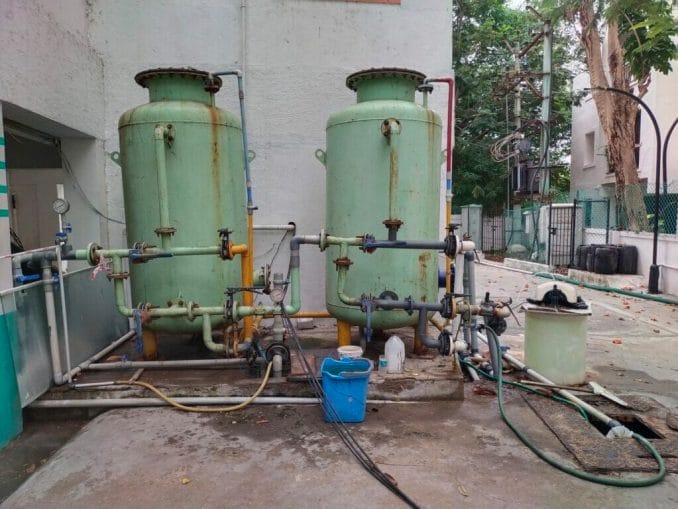 From the filter inlet, the water is sent to the sand filter (the first green tank) and then to the carbon filter (the second green tank). The carbon filter is used for decolorization. Image: Shobana Radhakrishnan
From the filter inlet, the water is sent to the sand filter (the first green tank) and then to the carbon filter (the second green tank). The carbon filter is used for decolorization. Image: Shobana Radhakrishnan
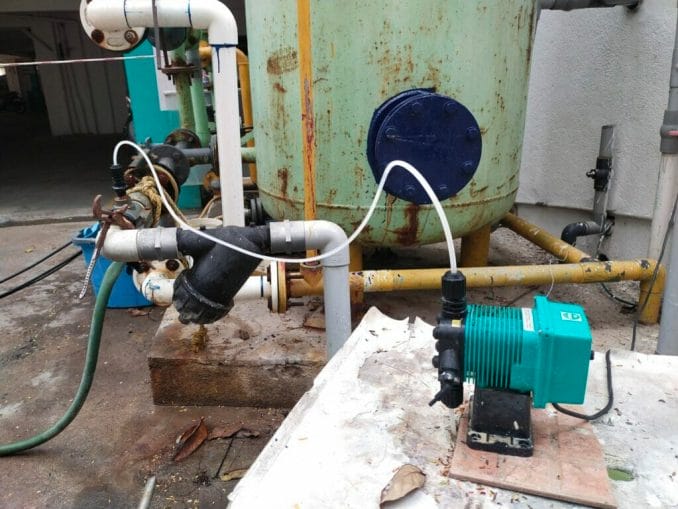 After treatment in the carbon filter tank, chlorine is added to the water using a motor. Image: Shobana Radhakrishnan
After treatment in the carbon filter tank, chlorine is added to the water using a motor. Image: Shobana Radhakrishnan
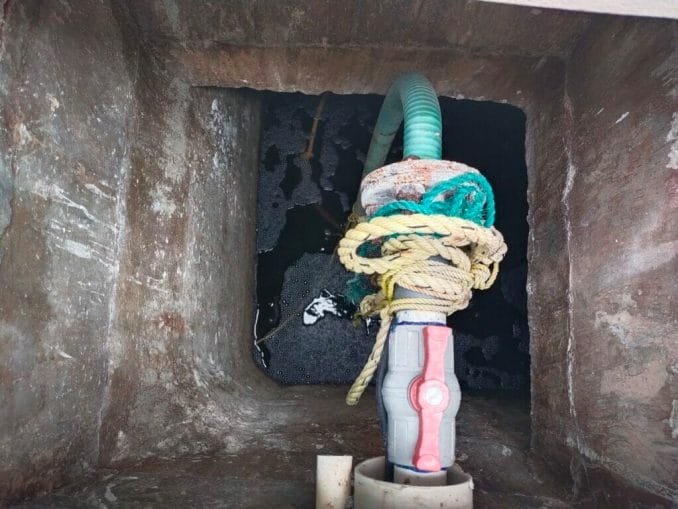 The treated water is later collected in the tank and from there fed into the apartments for rinsing. Image: Shobana Radhakrishnan
The treated water is later collected in the tank and from there fed into the apartments for rinsing. Image: Shobana Radhakrishnan
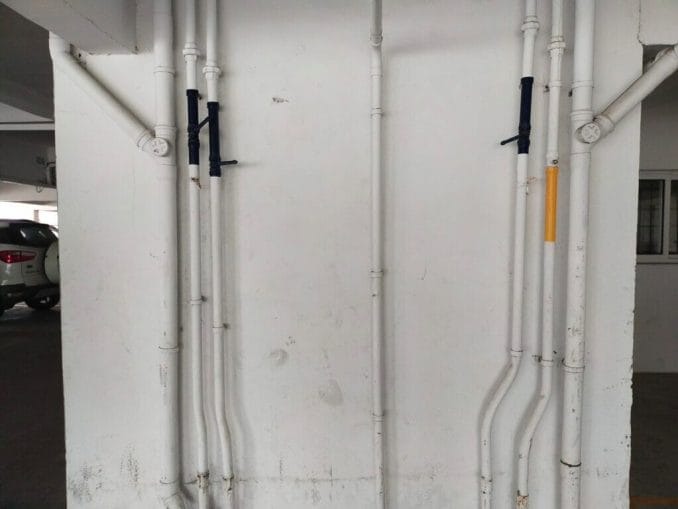 The cleaned waste water is fed through the yellow pipe for rinsing. Image: Shobana Radhakrishnan
The cleaned waste water is fed through the yellow pipe for rinsing. Image: Shobana Radhakrishnan
Monitoring mechanism of the STP
The STP is set up to monitor quantity, quality and power consumption throughout the process.
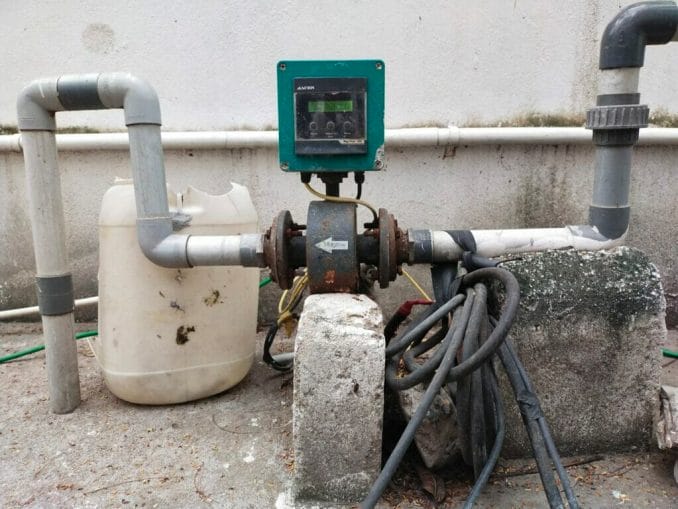 The live counter that counts the amount of raw water at the inlet. On that day, the inflow of raw water was almost 05.31 m3/h. Image: Shobana Radhakrishnan
The live counter that counts the amount of raw water at the inlet. On that day, the inflow of raw water was almost 05.31 m3/h. Image: Shobana Radhakrishnan
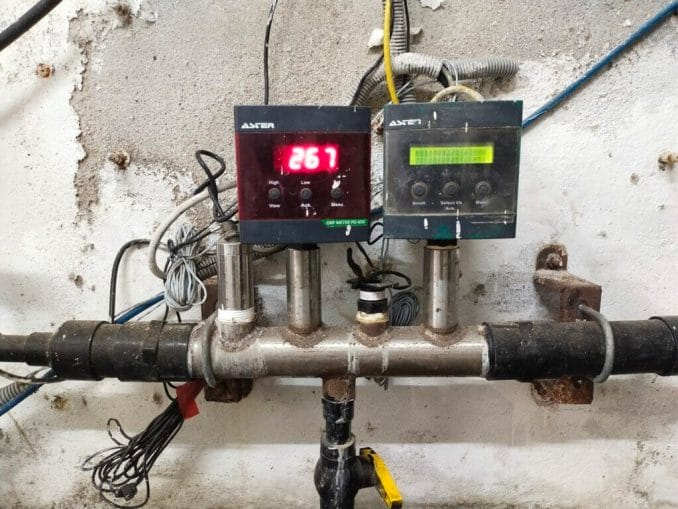 While the ORP meter is used to measure the chlorine level in the water, the other meter here is used to measure the amount of outlet flow. On this day, the outlet flow was 04.89 m3/h. Image: Shobana Radhakrishnan
While the ORP meter is used to measure the chlorine level in the water, the other meter here is used to measure the amount of outlet flow. On this day, the outlet flow was 04.89 m3/h. Image: Shobana Radhakrishnan
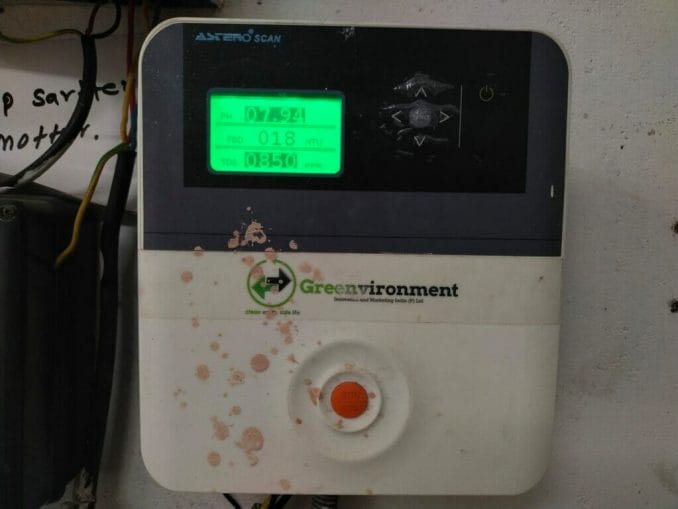 The pH of the treated water is normally maintained between 7 and 8 and is continuously monitored along with turbidity and total dissolved solids (TDS). Image: Shobana Radhakrishnan
The pH of the treated water is normally maintained between 7 and 8 and is continuously monitored along with turbidity and total dissolved solids (TDS). Image: Shobana Radhakrishnan
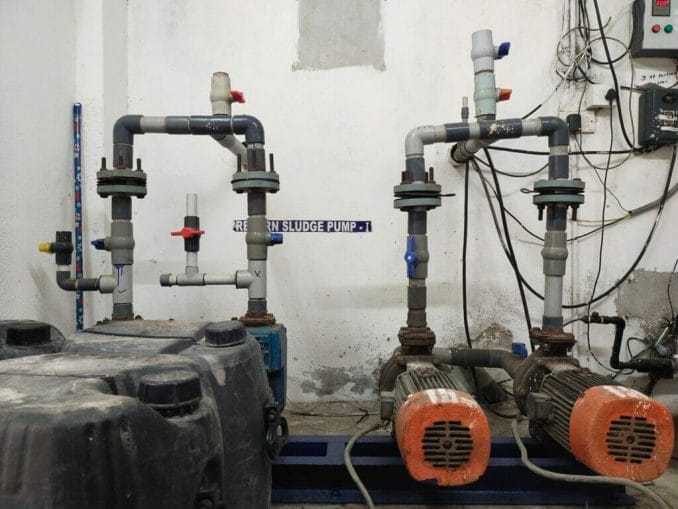 A return slurry pump is used to pump the slurry back into the system. Image: Shobana Radhakrishnan
A return slurry pump is used to pump the slurry back into the system. Image: Shobana Radhakrishnan
With an inflow of 05.31 m3/h there was an outflow of 04.89 m3/h. “The rest is the mud. While most homes use tankers to remove this sludge, we have redesigned the treatment plant to pump the sludge back into the system and process it again. This way, there is no need for an outside agency to remove the mud,” says Rakesh, adding that this redesigned model allows STP to be self-sufficient in their Chennai apartment.
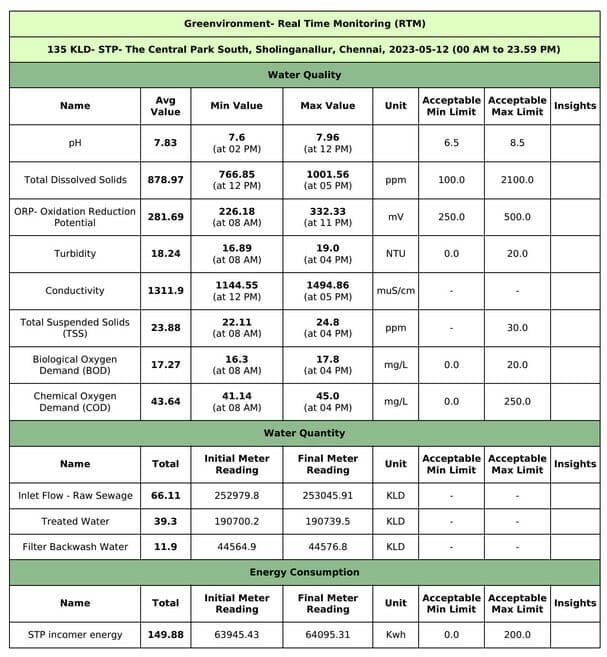 Records from online surveillance system. Image Courtesy: Rakesh Ohri
Records from online surveillance system. Image Courtesy: Rakesh Ohri
A contractor was also hired to install and maintain the continuous online monitoring system. Accordingly, the SHEV officers receive daily reports on the water quality, volume and energy consumption, and they also have access to monitoring the fill levels at any time of the day.
About 20 to 25 power units are consumed for STP alone. On average, 6,000 rupees per day is spent on electricity. Standard common room rates will be charged according to the revised standards.
Including the staff salary, the contractor’s online monitoring system, chemicals and other maintenance costs, the apartment spends about Rs 1.3 lakhs monthly on the STP. This feeds into the maintenance cost of each apartment (172 apartments) at an average rate of 50 paise per square foot.
Read more: Sewage trucks pollute Chennai’s lakes and drains with impunity
Challenges in maintaining STPs in Chennai
Since said apartment complex is located in a low-lying area, there is a risk of flooding even if it rains for a short period of time. After the 2015 Chennai floods that damaged STP at its Chennai condominium complex, RWA took action to construct underground tanks and diesel engine pumps to pump out the flooded water. They also overhauled the STP by making some changes to the system.
“Over the years, the functioning of STP has stabilized. However, constant monitoring is a challenge. One of us on the team should oversee this and make sure things are in order on a daily basis,” says Rakesh, adding that hiring and retaining people is another big challenge as the staff isn’t outsourced by an agency. Rather, you hire them directly.
The greatest challenges in operating the STPs in such residential complexes often arise when the client hands over operation to the RWAs.
“Because RWAs are a small group of people who don’t have the skills or knowledge to operate and maintain these STPs, they often shut them down. This is where the Federation of OMR Resident Association (FOMRRA) comes in to help SHEVs provide them with the right vendor, staff, chemical or other necessities,” says Harsha Koda, co-founder of FOMRRA.
Harsha also adds that the operating and maintenance costs of an STP in a small apartment complex (e.g. 50 units) will be around 20,000-30,000 rupees excluding electricity costs.
“The biggest challenge is understanding how the technology works,” says Harsha. “There are greywater STPs (recycles water used in the shower, dishwashing and kitchen sink) and blackwater STPs (recycles water used to flush the toilet). One needs to know the difference between such STPs and how they work. There are now enough resources and maintaining an STP does not pose much of a challenge.”
At a time when Chennai is experiencing high-rise construction and water and sanitation management is a challenge for the city’s growing population, technology is here to help. The model adopted by Central Park South can prevent the illegal discharge of wastewater into water bodies and ensure that the treated water is reused.



Comments are closed.